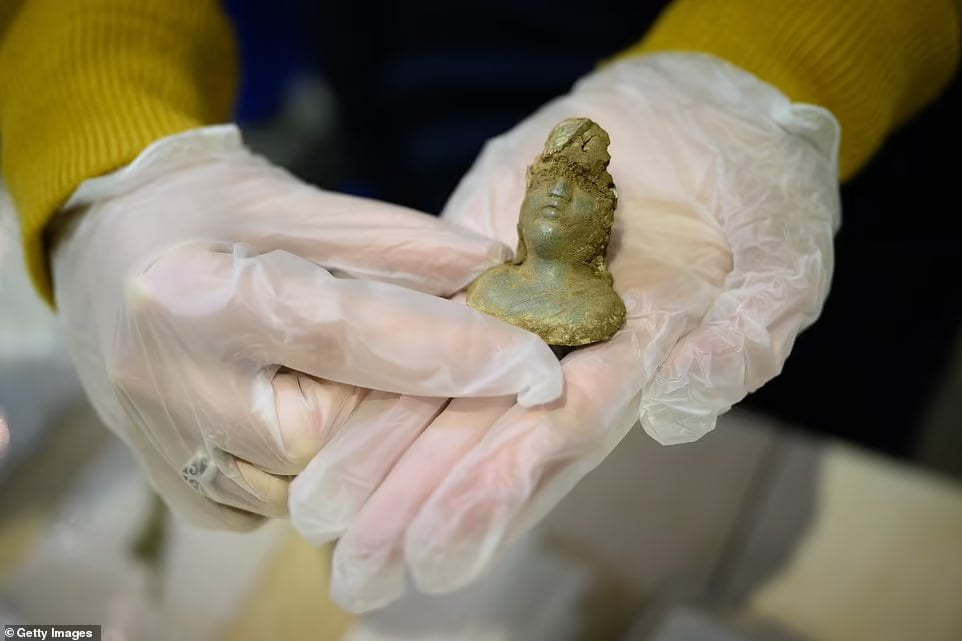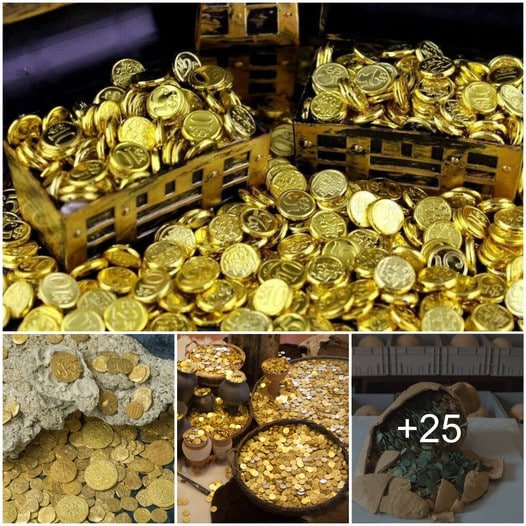
Researchers excavating the area for the HS2 project have uncovered fascinating insights into the transformation of an Iron Age village in Northamptonshire into a prosperous Roman trading town bustling with activity nearly two millennia ago.
Exciting finds unearthed during the excavation near the village of Chipping Warden – referred to as Blackgrounds due to the dark soil found in the area – include cremation urns, gaming pieces, shackles, a snake-head brooch, and over 300 Roman coins. Evidence indicates that the settlement was established around 400 BC, consisting of more than 30 roundhouses. However, it underwent significant expansion during the Roman era around 300-400 AD, featuring new stone buildings and roads.

A group of around 80 archaeologists involved in the HS2 high-speed rail project have spent the last year excavating Blackgrounds, one of over 100 sites surveyed between London and Birmingham since 2018.
Experts believe that the discovery of the remains of the Roman trading town is a significant archaeological find during the controversial £100 billion railway project.
Prior to constructing bridges, tunnels, tracks, and stations for HS2, an unprecedented amount of archaeological work is being carried out along the route to ensure that important historical artifacts are not overlooked or buried.
This excavation work presents a unique opportunity to uncover and share the story of Britain, according to HS2 Ltd, the government-funded organization responsible for implementing the project. Despite being mired in controversy for its impact on historic buildings and natural landscapes, the project aims to shed light on the country’s past.

In this image, the walls of a residential building are revealed during the excavation at the Blackgrounds Roman archaeological site. The team of archaeologists from HS2 Ltd has uncovered a significant archaeological site near a quaint village in South Northamptonshire.

Shown is the remains of a Romani wall found at the Blackgrounds location. Research indicates that the community was founded around 400 BC, during the Iron Age.

A picture released by HS2 depicts a Roman dice and board game pieces unearthed during the archaeological dig at Blackgrounds.

Shown in the image is ornamental Roman pottery discovered on the premises. Over the course of a year, approximately 80 archaeologists working on the HS2 project have dedicated their efforts to uncovering and excavating the site.

Over 300 Roman coins were discovered at a site located just north of Chipping Warden in Northamptonshire. The excavation revealed a Roman female deity scale weight at Blackgrounds, named for its black soil. The image was released by HS2.

Archaeologists have discovered a Roman cremation urn buried in soil, indicating the presence of an Iron Age village that later grew into a prosperous Roman trading town.

Depicted is an intricately designed Roma spoke-head brooch that caught the attention of experts due to its detailed carvings. The discovery of an Iron Age settlement in the area left archaeologists stunned. Though the presence of a significant archaeological site has been known since the 18th century, recent surveys have unveiled the original Iron Age section of the site along with artifacts from the Roman settlement.
James West, the site manager from the Museum of London Archaeology Headland Infrastructure, expressed his excitement over the excavation, stating that it has exceeded all expectations. He mentioned that this site is among the most impressive they have uncovered during the HS2 scheme. Understanding the evolving story of Blackgrounds, spanning multiple time periods, has been a highlight for him.
The discovery of a well-preserved and expansive Roman road, along with numerous high-quality finds, has provided valuable insights into the lives of the ancient inhabitants. West believes that the site has the potential to revolutionize our understanding of the Roman landscape in the region and beyond.
Running through the site is a massive Roman road, measuring 32 feet or 10 meters wide, which is unusually wide compared to typical Roman roads that were around 13 feet (4 meters) wide.

Another picture captured during the archaeological excavation for HS2 shows a Roma lead die surrounded by bone gaming pieces.

Shown in the images are Roma people crafting various accessories. Several archaeological sites in Northamptonshire are currently being investigated, including Blackgrounds, Edgcote battleground, and an abandoned medieval village at Radstone.

The HS2 photo reveals a collection of Roma artifacts carefully marked and stored in bags and plastic containers during excavation.

A heavy metal object designed to resemble a human head was discovered on the HS2 route in Northamptonshire by the Museum of London Archaeology (MOLA) on January 10, 2022.

Environmental Scientist and Analyst Donna Brady inspects dehydrated specimens of animal bones and charcoal collected from the HS2 construction site.

Claire, the manager of programmes at MOLA (also known as the Museum of London Archaeology), proudly displays a lead weight shaped like a head that was discovered along the route of the HS2 excavation.

Rob Pearce, a Field and Environmental Processor, sorts and purifies the contents of the sample buckets collected along the route using Siraf tanks.

Clare Finn from MOLA discussed the necessary drying process for the trays containing samples from the route of HS2. The archaeologists working on the high-speed rail project discovered artifacts at the Blackgrounds Roman-era trading settlement.

The city of Rome originated during the era of Emperor Constantine, featuring a portrayal of Romulus and Remus and celebrating the establishment of the city.

A worker at the site displayed a Roman pot they found. Blackgrounds, originally a village with over 30 roundhouses, dates back to the Iron Age.

